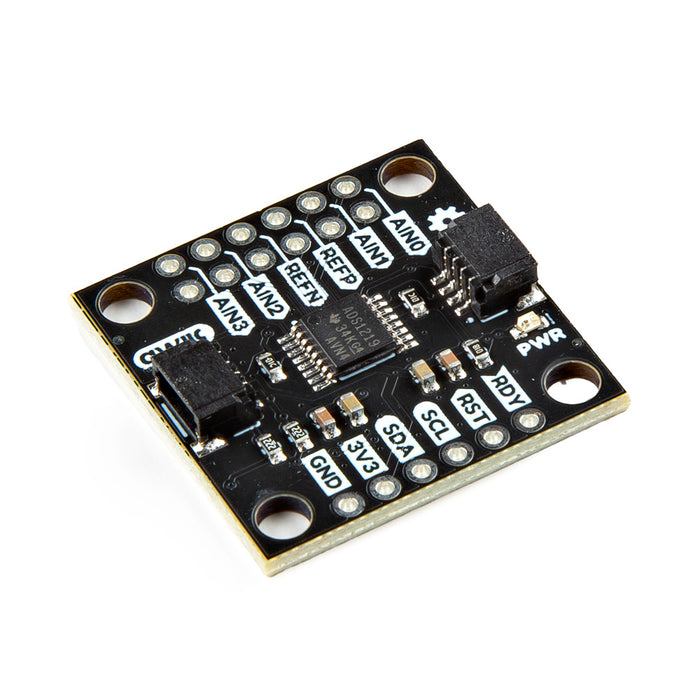
SparkX Qwiic 24 Bit ADC - 4 Channel (ADS1219)
A lot of the time you just need to add more analog inputs to solve a problem. It happens. The SparkX Qwiic 24-Bit ADC can provide four channels of I2C controlled ADC input to your Qwiic enabled project. These channels can be used as single-ended inputs, or in pairs for differential inputs, running at sample rates of up to 1kHz. What makes this ADC even more powerful is that it has a programmable x1 or x4 gain amplifier that lets you "zoom in" on a very small change in analog voltage (but will still effect your input range and resolution). Utilizing our handy Qwiic system, it is easy to connect it to the rest of your system. However, we have broken out 0.1"-spaced pads too in case you prefer to use a breadboard. The analog inputs and reference pins are all broken out on 0.1"-spaced pads too. This board does not have screw terminals - there was not enough room!
The ADS1219 can use its own internal 2.048V voltage reference for measurements, or you can provide your own reference via the REFP and REFN breakout pads. You can also provide your own VDDA (AVDD) by opening the jumper and connecting a voltage to the VDDA pad. This ADC board has eight address jumpers that let you choose one of sixteen unique addresses (0x40 to 0x4F). With this, you can connect up to sixteen of these on the same I2C bus and have 64 channels of ADC. The maximum resolution of the converter is 24-bits, corresponding to 244.14nV per count at a gain of x1. At a gain of x4, the resolution is 61.04nV per count. Note: the effective resolution is limited to 20-bits.
We have written an Arduino Library to make it easy to add the ADS1219 into your project.
Note: The default I2C address of the ADS1219 is 0x40 and is jumper selectable in the range 0x40 to 0x4F. If you need to use more than sixteen ADS1219 ADCs, consider using the Qwiic Mux Breakout.
The SparkFun Qwiic connect system is an ecosystem of I2C sensors, actuators, shields and cables that make prototyping faster and less prone to error. All Qwiic-enabled boards use a common 1mm pitch, 4-pin JST connector. This reduces the amount of required PCB space, and polarized connections mean you can’t hook it up wrong.
Features:
- ADS1219
- Operating Voltage (VDD): 2.3V - 5.5V
- (Note: When powering with a Qwiic cable, the operating voltage is 3.3V only)
- Operating Temperature: -40°C to 125°C
- Operation Modes: Single-Shot, Continuous-Conversion, and Power-Down
- Analog Inputs:
- Four single-ended
- Can be configured as one or two differential inputs
- Separate reference voltage inputs
- VDDA (AVDD) can also be configured via the jumper and breakout pad
- Resolution:
- 24-bit maximum, 20-bit effective
- LSB size (gain x1): 244.14nV
- LSB size (gain x4): 61.04nV
- Sample Rate: 20 Hz to 1 kHz
- Combined Current Consumption (Typical): 8μA - 410μA
- 50Hz and 60Hz noise rejection
- Configurable input multiplexer
- Operating Voltage (VDD): 2.3V - 5.5V
- Sixteen configurable I2C addresses:
- 0x40 - 0x4F
- Default: 0x40
- 2x Qwiic connection ports
- Power LED (configurable)
- Dimensions: 1" x 1"
Documents:
The SparkX Qwiic 24 Bit ADC - 4 Channel (ADS1219) appears in the following collections:




